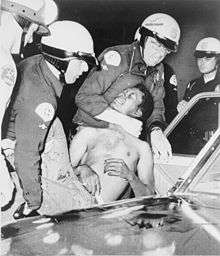Mass racial violence in the United States
Mass racial violence in the United States, also called race riots, can include such disparate events as:
- racially based communal conflict against African Americans that took place before the American Civil War, often in relation to attempted slave revolts, and after the war, in relation to tensions under Reconstruction and later efforts to suppress black voting and institute Jim Crow and white supremacy.
- conflict between Americans and recent European immigrants in the 19th and 20th centuries.
- attacks on Native Americans and Americans over the land.
- frequent fighting among various ethnic groups in major cities, specifically in the Northeast and Midwest United States throughout the late 19th century and early 20th century. One example was explored in the stage musical West Side Story and its film adaptation, about ethnic conflict in New York between Puerto Ricans and Italians.
- violence against Latin American immigrants in the 20th century.
- Mass violence and looting within African-American, Mexican-American and Puerto Rican American communities during the civil rights movement in the 1960s and 1970s, such as the 1967 nationwide riots in most major U.S. cities that led to over 100 deaths, and the 1968 riots following the assassination of Martin Luther King, Jr.
Anti-immigrant and anti-Catholic violence
Riots defined by "race" have taken place between ethnic groups in the United States since the 18th century and likely before. During the early-to-mid- 19th centuries, violent rioting occurred between Protestant "Nativists" and recently arrived Irish Catholic immigrants. These reached heights during the peak of immigration in the 1840s and 1850s in cities such as New York, Philadelphia, and Boston. During the early 20th century, riots were common against Irish and French-Canadian immigrants in Providence, Rhode Island.
The San Francisco Vigilance Movements of 1851 and 1856 have been described as responses to rampant crime and government corruption. But, since the late 20th century, historians have noted that the vigilantes had a nativist bias; they systematically attacked Irish immigrants, and later Mexicans and Chileans who came as miners during the California Gold Rush, and Chinese immigrants. During the early 20th century, racial or ethnic violence was directed by whites against Filipinos, Japanese and Armenians in California, who had arrived in waves of immigration.
During the late 19th century and early 20th century, Italian immigrants were subject to racial violence. In 1891, eleven Italians were lynched by a mob of thousands in New Orleans.[1] In the 1890s a total of twenty Italians were lynched in the South. Anti-Polish violence also occurred in the same time period.
The Reconstruction Era (1863-1877)
Immediately following the Civil War, political pressure from the North called for a full abolition of slavery. The South's lack of voting power led to the passing of the 13th, 14th and 15th amendments, which in theory gave African-Americans and other minorities equality and voting rights, along with abolishing slavery. Although the federal government originally kept troops in the South to protect these new freedoms, this time of progress was cut short.[2]
By 1877 the North had lost its political will in the South and while slavery remained abolished, the Black Codes and segregation laws helped erase most of the freedoms passed by the 14th and 15th amendments. Through violent economic tactics and legal technicalities, African-Americans were forced into sharecropping and were gradually removed from the voting process.[2]
African-Americans were not alone in experiencing racial violence, as by 1866, General William Sherman[3] called for
At least 10 Indians are to be killed for each white life lost. You should not allow the troops to settle down on the defensive but carry the war to the Indian camps, where the women and children...[You] should not delay the punishment of the Indians as a people.[2]
The Lynching Era (1878-1939)
Lynchings, defined by "the killing of an individual or small group of individuals by a 'mob' of people" was a particular form of ritualistic murder, usually involving the majority of the local white community. Lynching was announced in advance and became a spectacle for an audience to witness. Lynches in the United States dropped overall in number from the 1880s to the 1920s, but there was still an average of about 30 lynchings per year during the 1920s. A study done of 100 lynchings from 1929 to 1940 discovered that at least one third of the victims were innocent of the crimes they were accused of.[4]
Racial and ethnic cleansing took part on a large-scale size in this time period, particularly towards Native Americans, who were forced off their land and relocated to reservations. Along with Native Americans, Chinese-Americans in the Pacific Northwest and African-Americans throughout the United States were rounded up and expunged from towns under threat of mob rule, often intending to harm their targets.[4]
The Civil Rights Era (1940-1971)
Though the Roosevelt administration, under tremendous pressure, engaged in anti-racist propaganda and in some cases helped push for African-American employment, African Americans were still experiencing immense violence, particularly in the South. In March 1956, United States Senator Sam Ervin of North Carolina created the Southern Manifesto,[5] which promised to fight to keep Jim Crow alive by all legal means.[6]
This continuation of support for Jim Crow and segregation laws led to protests in which many African-Americans were violently injured out in the open at lunchroom counters, buses, polling places and local public areas. These protests did not eviscerate racism, but it forced racism to become used in more coded or metaphorical language instead of being used out in the open.[6]
The Modern Era (1972-Present)
Today racial violence has changed dramatically, as open violent acts of racism are rare, but acts of police brutality and the mass incarceration of racial minorities continues to be a major issue facing the United States. The War on Drugs[7] has been noted as a direct cause for the dramatic increase in incarceration, which has risen from 300,000 to more than 2,000,000 from 1980 to 2000 in the nation's prison system.
While the rates of drug use for African-Americans, Latinos and Caucasians are almost equal, there is a massive inequality in African-American and Latinos sent to prison for drug related crimes. Drug crimes aside, Latinos and African-Americans are being incarcerated at a much larger rate than Caucasians. This has led to an alarming fact that in 2006, 1 out of every 14 African-American men were in prison, compared to only 1 out of every 106 white men. With current trends forecasting that 1 in 3 black men in the United States will go to prison or jail, focus on fixing criminal issues with minorities has been placed to the forefront of pressing problems in the United States.
Nineteenth-century events
Like lynchings, race riots often had their roots in economic tensions or in white defense of the color line. In 1887, for example, ten thousand workers at sugar plantations in Louisiana, organized by the Knights of Labor, went on strike for an increase in their pay to $1.25 a day. Most of the workers were black, but some were white, infuriating Governor Samuel Douglas McEnery, who declared that "God Almighty has himself drawn the color line." The militia was called in, but withdrawn to give free rein to a lynch mob in Thibodaux. The mob killed between 20 and 300 blacks. A black newspaper described the scene:
'Six killed and five wounded' is what the daily papers here say, but from an eye witness to the whole transaction we learn that no less than thirty-five Negroes were killed outright. Lame men and blind women shot; children and hoary-headed grandsires ruthlessly swept down! The Negroes offered no resistance; they could not, as the killing was unexpected. Those of them not killed took to the woods, a majority of them finding refuge in this city.[8]
In 1891, a mob lynched Joe Coe, a black worker in Omaha, Nebraska suspected of attacking a young white woman from South Omaha. Approximately 10,000 white people, mostly ethnic immigrants from South Omaha, reportedly swarmed the courthouse, setting it on fire. They took Coe from his jail cell, beating and then lynching him. Reportedly 6,000 people visited Coe's corpse during a public exhibition, at which pieces of the lynching rope were sold as souvenirs. This was a period when even officially sanctioned executions, such as hangings, were regularly conducted in public.[9]
Twentieth-century events
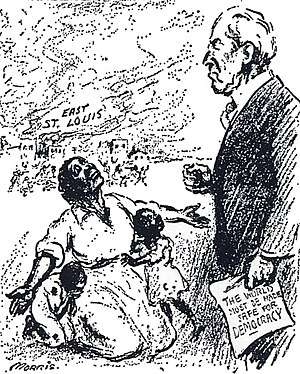
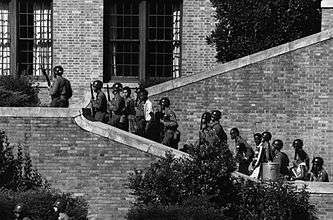
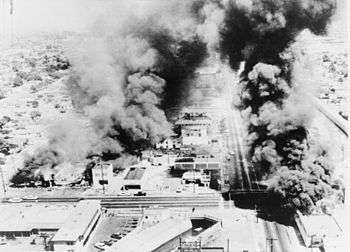

Labor and immigrant conflict was a source of tensions that catalyzed as the East St. Louis riot of 1917. White rioters, many of them ethnic immigrants, killed an estimated 100 black residents of East St. Louis, after black residents had killed two white policemen, mistaking the car they were riding in for a previous car of white occupants who drove through a black neighborhood and fired randomly into a crowd of black people .
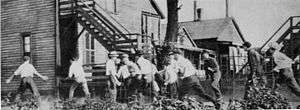
White-on-Black race riots include the Atlanta riots (1906), the Omaha and Chicago riots (1919), part of a series of riots in the volatile post-World War I environment, and the Tulsa riots (1921).
The Chicago race riot of 1919 grew out of tensions on the Southside, where Irish descendants and African Americans competed for jobs at the stockyards, and where both were crowded into substandard housing. The Irish descendants had been in the city longer, and were organized around athletic and political clubs.
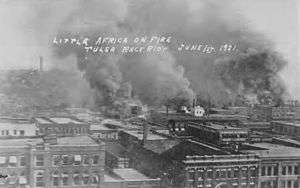
A young black Chicagoan, Eugene Williams, paddled a raft near a Southside Lake Michigan beach into "white territory", and drowned after being hit by a rock thrown by a young white man. Witnesses pointed out the killer to a policeman, who refused to make an arrest. An indignant black mob attacked the officer.[10] Violence broke out across the city. White mobs, many of them organized around Irish athletic clubs, began pulling black people off trolley cars, attacking black businesses, and beating victims. Having learned from the East St. Louis riot, the city closed down the street car system, but the rioting continued. A total of 23 black people and 15 white people were killed.[11]
The 1921 Tulsa race riot was the result of economic competition, and white resentment of black successes in Greenwood, which was compared to Wall Street and filled with independent businesses. In the immediate event, black people resisted white people who tried to lynch 19-year-old Dick Rowland, who worked at shoeshines. Thirty-nine people (26 black, 13 white) were confirmed killed. An early 21st century investigation of these events has suggested that the number of casualties could be much higher. White mobs set fire to the black Greenwood district, destroying 1,256 homes and as many as 200 businesses. Fires leveled 35 blocks of residential and commercial neighborhood. Black people were rounded up by the Oklahoma National Guard and put into several internment centers, including a baseball stadium. White rioters in airplanes shot at black refugees and dropped improvised kerosene bombs and dynamite on them.[12]
By the 1960s, decades of racial, economic, and political forces, which generated inner city poverty, resulted in "race riots" within minority areas in cities across the United States. The beating and rumored death of cab driver John Smith by police, sparked the 1967 Newark riots. This event became, per capita, one of the deadliest civil disturbances of the 1960s. The long and short term causes of the Newark riots are explored in depth in the documentary film Revolution '67 and many news reports of the times. The riots in Newark spread across the United States in most major cities and over 100 deaths were reported. Many inner city neighborhoods in these cities were destroyed. The assassinations of Rev. Martin Luther King, Jr. in Memphis, Tennessee and later of Robert Kennedy in Los Angeles in 1968 also led to nationwide rioting across the country with similar mass deaths. During the same time period, and since then, violent acts committed against African-American churches and their members have been commonplace.
During the 1980s and '90s a number of riots occurred that were related to longstanding racial tensions between police and minority communities. The 1980 Miami riots were catalyzed by the killing of an African-American motorist by four white Miami-Dade Police officers. They were subsequently acquitted on charges of manslaughter and evidence tampering. Similarly, the six-day 1992 Los Angeles riots erupted after the acquittal of four white LAPD officers who had been filmed beating Rodney King, an African-American motorist. Khalil Gibran Muhammad, the Director of the Harlem-based Schomburg Center for Research in Black Culture has identified more than 100 instances of mass racial violence in the United States since 1935 and has noted that almost every instance was precipitated by a police incident.[13]
Twenty-first-century events
The Cincinnati riots of 2001 were caused by the killing of 19-year-old African-American Timothy Thomas by white police officer Stephen Roach, who was subsequently acquitted on charges of negligent homicide.[14] The 2014 Ferguson unrest occurred against a backdrop of racial tension between police and the black community of Ferguson, Missouri in the wake of the police shooting of Michael Brown; similar incidents elsewhere such as the shooting of Trayvon Martin sparked smaller and isolated protests. According to the Associated Press' annual poll of United States news directors and editors, the top news story of 2014 was police killings of unarmed black people, including Brown, as well as the investigations and the protests afterward.[15][16] During the 2017 Unite the Right Rally, an attendee drove his car into a crowd of people protesting the rally, killing 32-year-old Heather D. Heyer and injuring 19 others, in what police called a deliberate attack.
Timeline of events
Nativist period 1700s–1860
- For information about riots worldwide, see List of riots.
- 1763: Pontiac's War
- 1829: Cincinnati riot of 1829 (Cincinnati, Ohio)
- Rioting against African Americans results in thousands leaving for Canada.
- 1829: Charlestown anti-Catholic riots (Charlestown, Massachusetts)
- 1831: Nat Turner's slave rebellion (Southampton County, Virginia)
- 1834: Massachusetts Convent Burning
- 1835: Washington DC Snow Riot
- 1835: Five Points Riot (New York City)
- 1841: Cincinnati riot of 1841 (Cincinnati, Ohio)
- 1844: Philadelphia Nativist Riots (May 6–8/July 5–8)
- 1851: Hoboken anti-German riot
- 1855: Bloody Monday (Louisville, KY Anti-German riots)
Civil War period 1861–1865
- 1863: Detroit race riot
- 1863: New York City Draft Riot
Post–Civil War and Reconstruction period: 1865–1889
- 1866: New Orleans riot (New Orleans, Louisiana)
- 1866: Memphis riots of 1866 (Memphis, Tennessee)
- 1868: Pulaski riot (Pulaski, Tennessee)
- 1868: Opelousas massacre (Opelousas, Louisiana)
- 1868: Camilla race riot
- 1868: Ward Island riot
- Irish and German-American indigent immigrants, temporarily interned at Wards Island by the Commissioners of Emigration, begin rioting following an altercation between two residents, resulting in thirty men seriously wounded and around sixty arrested.[17]
- 1870: Eutaw, Alabama
- 1870: Laurens, South Carolina
- 1870: Kirk-Holden war: Alamance County, North Carolina
- Federal troops, led by Col. Kirk and requested by NC governor Holden, were sent to extinguish racial violence. Holden was eventually impeached because of the offensive.
- 1870: New York City orange riot
- 1871: Meridian race riot of 1871, Mississippi
- 1871: Second New York City orange riot
- 1871: Los Angeles anti-Chinese riot
- 1871: Scranton coal riot
- Violence occurs between striking members of a miners' union in Scranton, Pennsylvania when Welsh miners attack Irish and German-American miners who chose to leave the union and accept the terms offered by local mining companies.[18]
- 1873: Colfax, Louisiana
- 1874: Vicksburg, Mississippi
- 1874: New Orleans, Louisiana
- 1874: Coushatta massacre, Coushatta, Louisiana
- 1875: Yazoo City, Mississippi
- 1875: Clinton, Mississippi
- 1876: Statewide violence in South Carolina
- 1876: Hamburg, South Carolina
- 1876: Ellenton, South Carolina
- 1885: Rock Springs, Wyoming
- 1885: Tacoma, Washington
- 1886: Pittsburgh riot
- 1886: Seattle, Washington
- 1887: Denver riot of 1887
- 1887: Hells Canyon Massacre
- In one of the largest civil disturbances in the city's history, fighting between Swedish, Hungarian and Polish immigrants resulted in the shooting death of one man and several others were injured before it was broken up by police.[19]
- 1887: Thibodaux massacre, Thibodaux, Louisiana—strike of 10,000 sugar-cane workers was opposed by whites, who rioted and killed an estimated 50 African Americans
Jim Crow period: 1890–1914
- A lynch mob storms a local jail and hangs 11 Italians following the acquittal of several Sicilian immigrants alleged to be involved in the murder of New Orleans police chief David Hennessy.
- 1891: 1st Omaha race riot
- 10,000 white people storm the local courthouse to beat and lynch Joe Coe, alleged to have raped a white girl.
- 1894: Buffalo, New York riot of 1894
- Two groups of Irish and Italian-Americans are arrested by police after fighting following a barroom brawl. After the mob is dispersed by police, five Italians are arrested while two others are sent to a local hospital.[20]
- Much of the violence in this national strike was not specifically racial. In Iowa, where employees of Consolidation Coal Company (Iowa) refused to join the strike, armed confrontation between strikers and strike breakers took on racial overtones because the majority of Consolidation's employees were African American. The National Guard was mobilized to avert open warfare.[21][22][23]
- A group of Democrats sought to remove African-Americans from the political scene, and went about this by launching a campaign of accusing African-American men of sexually assaulting white women. About five hundred white men attacked and burned Alex Manly's office, a newspaper editor who suggested African-American men and white women had consensual relationships. Fourteen African-Americans were killed.[24]
- 1898: Lake City, South Carolina
- 1898: Greenwood County, South Carolina
- 1899: Newburg, New York riot
- Angered about hiring of African-American workers, a group of 80-100 Arab laborers attack African Americans near the Freeman & Hammond brick yard, with numerous men injured on both sides.[25]
- 1900: New Orleans, Louisiana: Robert Charles riots
- 1900: New York City
- 1902: New York City
- Anti-Semitic riots initiated by Irish factory workers and city policemen against thousands of Jews attending Jacob Joseph's funeral
- 1906: Little Rock, Arkansas
- Started after a white police officer in Argenta (North Little Rock) killed a black musician, and another black was killed; racial tensions rose with exchange of gunfire, resulting in half a block of buildings burned down; whites rioted and some blacks fled the city.[26]
- 1906: Atlanta riots, Georgia
- In September after two newspapers printed stories about African-American men assaulting white women anti-African-American violence broke out. Roughly 10,000 white men and boys took the street, resulting in the deaths of 25 to 100 African-Americans, along with hundreds injured.[24]
- 1906: Wahalak & Scooba, Mississippi[27]
- 1907: Bellingham riots, Washington
- 1908: Springfield, Illinois
- 1909: Greek Town riot
- A successful Greek immigrant community in South Omaha, Nebraska is burnt to the ground by ethnic whites and its residents are forced to leave town.[28]
- 1910: Nationwide riots following the heavyweight championship fight between Jack Johnson and Jim Jeffries in Reno, Nevada on July 4
- 1910 Slocum, Texas massacre, between eight and two hundred black residents around Slocum, Texas were killed by hundreds of armed white men. Eleven white men were arrested, none went to trial.[29]
War and Inter-War period: 1914–1945
- 1917: East St. Louis, Illinois
- On July 1st, an African-American man was rumored to have killed a white man. Violence against African-American continued for a week, resulting in estimations of 40 to 200 dead African-Americans. In addition, almost 6,000 African-Americans lost their homes during the riots then fled East St. Louis.[24]
- 1917: Chester, Pennsylvania
- 1917: Philadelphia, Pennsylvania
- 1917: Houston, Texas
- Red Summer of 1919
- Tension in the summer of 1919 stemmed significantly from white soldiers returning from World War I and finding that their jobs had been taken by African Americans who had migrated to the North.[24]
- 1919: Washington, D.C.
- 1919: Chicago, Illinois
- 1919: Omaha, Nebraska
- 1919: Charleston, South Carolina
- 1919: Longview, Texas
- 1919: Knoxville, Tennessee
- 1919: Elaine, Arkansas
- 1920: Ocoee, Florida
- 1920: West Frankfort, Illinois
- 1921: Tulsa, Oklahoma
- Between May 31st and June 1st, a young white woman accused an African American man of grabbing her arm in an elevator. The man Dick Rowland was arrested and police launched an investigation. A mob of armed white men gathered outside the Tulsa County Courthouse, where gunfire ensued. During the violence, 1,250 homes were destroyed and roughly 6,000 African-Americans were imprisoned after the Oklahoma National Guard was called in. The state of Oklahoma reports that twenty-six African-Americans died along with 10 whites.
- 1923: Rosewood, Florida (area is now an outgrowth of Cedar Key, Florida)
- 1927: Little Rock, Arkansas
- Lynching of John Carter, a suspect in a murder, was followed by rioting by 5,000 whites in the city, who destroyed a black business area[30]
- A wave of civil unrest, violence, and vandalism by local White mobs against Blacks, as well Greek, Jewish, Chinese and Puerto Rican targets in the community.
- 1930: Watsonville, California
- 1935: Harlem, Manhattan, New York
- 1943: Detroit, Michigain
- In late June a fistfight broke out between an African-American man and a white man at an amusement park named Belle Isle. The violence escalated from there and led to three days of intense fighting, in which 6,000 United States Army troops were brought in. This resulted in twenty-five African-Americans dying, along with nine white deaths and a total of seven hundred injured persons.[24]
- 1943: Harlem, Manhattan, New York
- 1943: Los Angeles, California
- 1944: Guam
Civil Rights Movement: 1955–1973
1963
1964
- Rochester 1964 race riot; Rochester, New York – July
- New York City 1964 riot; New York City – July
- Philadelphia 1964 race riot; Philadelphia – August
- Jersey City 1964 race riot, August 2–4, Jersey City, New Jersey
- Paterson 1964 race riot, August 11–13, Paterson, New Jersey
- Elizabeth 1964 race riot, August 11–13, Elizabeth, New Jersey
- Chicago 1964 race riot, Dixmoor riot, August 16–17, Chicago
1965
- Watts riots; Los Angeles, California – August
- This predominately African-American neighborhood exploded with violence from August 11th to August 17th after the arrest of 21-year old Marquette Frye, a black motorist who was arrested by a white highway patrolman. During his arrest a crowd had gathered and a fight broke out between the crowd and the police, escalating to the point in which rocks and concrete were thrown at police. 30,000 people were recorded participating in the riots and fights with police, which left thirty four people dead, 1,000 injured and 4,000 arrested.
1966
- Hough riots; Cleveland, Ohio – July
- Division Street riots; Chicago, Illinois – June
- Marquette Park riot; Chicago, Illinois - August
- Hunters Point riot; San Francisco – September
1967
- 1967 Newark riots; Newark, New Jersey – July
- 1967 Plainfield riots; Plainfield, New Jersey – July
- 12th Street riot; Detroit, Michigan – July
- 1967 New York City riot; Harlem, New York City - July
- Cambridge riot of 1967; Cambridge, Maryland - July
- 1967 Rochester riot; Rochester, New York - July
- 1967 Pontiac riot; Pontiac, Michigan - July
- 1967 Toledo riot; Toledo, Ohio - July
- 1967 Flint riot; Flint, Michigan - July
- 1967 Grand Rapids riot; Grand Rapids, Michigan - July
- 1967 Houston riot; Houston, Texas - July
- 1967 Englewood riot; Englewood, New Jersey - July
- 1967 Tucson riot; Tucson, Arizona - July
- 1967 Milwaukee riot; Milwaukee, Wisconsin – July
- Minneapolis North Side riots; Minneapolis-Saint Paul, Minnesota – August
- 1967 Albina Riot Portland, Oregon - August 30[31]
1968
- Orangeburg massacre; Orangeburg, South Carolina – February
- King assassination riots: 125 cities in April and May, in response to the murder of Martin Luther King, Jr. including:
- Baltimore riot of 1968; Baltimore Maryland
- 1968 Washington, D.C. riots; Washington, D.C.
- 1968 New York City riot; New York City
- West Side Riots; Chicago
- 1968 Detroit riot; Detroit, Michigan
- Louisville riots of 1968; Louisville, Kentucky
- Hill District MLK riots; Pittsburgh, PA
- Summit, Illinois, race riot at Argo High School, September 1968
- Miami, Florida riots
- 1968 Democratic National Convention
1969
- 1969 York race riot; York, Pennsylvania – July
- 1969 Hartford Riots, September 1–4, Hartford, Connecticut
1970
- Augusta riot; Augusta, Georgia – May
- Jackson State killings; Jackson, Mississippi – May
- Asbury Park riot; Asbury Park, New Jersey – July
- Chicano Moratorium, an anti Vietnam War protest turned riot in East Los Angeles – August
1971
- East LA Riots, January 31, East Los Angeles, California
- Bridgeport Riots, May 20–21, Bridgeport, Connecticut
- Chattanooga riot, May 21–24, Chattanooga, Tennessee
- Albuquerque Riots, June 13–14, Albuquerque, New Mexico
- Oxnard Riots, July 19, Oxnard, California
- Riverside Riots, August 8–9, Riverside, California
- Camden riots, August 19–22, Camden, New Jersey
1972
- Escambia High School riots; Pensacola, Florida
- Blackstone Park Riots, July 16–18, Boston, Massachusetts
1973
Post-Civil Rights Era: 1974–1988
1977
1978
1980
- Miami riot 1980 – following the acquittal of four Miami-Dade Police officers in the death of Arthur McDuffie. McDuffie, an African-American, died from injuries sustained at the hands of four white officers trying to arrest him after a high-speed chase.
Since 1988
- 1991: Crown Heights riot – May – between West Indian immigrants and the area's large Hasidic Jewish community, over the accidental killing of a Guyanese immigrant child by an Orthodox Jewish motorist. In its wake, several Jews were seriously injured; one Orthodox Jewish man, Yankel Rosenbaum, was killed; and a non-Jewish man, allegedly mistaken by rioters for a Jew, was killed by a group of African-American men.
- 1991: Overtown, Miami – In the heavily Black section against Cuban Americans, like earlier riots there in 1982 and 1984.
- 1992: 1992 Los Angeles riots – April 29 to May 5 – a series of riots, lootings, arsons and civil disturbance that occurred in Los Angeles County, California in 1992, following the acquittal of police officers on trial regarding the assault of Rodney King.
- 1995: St. Petersburg, Florida riot of 1996, caused by protests against racial profiling and police brutality.
- 2001: 2001 Cincinnati riots – April – in the African-American section of Over-the-Rhine.
- 2009: Oakland, CA – Riots following the BART Police shooting of Oscar Grant.
- 2012 Anaheim, California Riot—followed the shooting of two Hispanic males
- 2014: Ferguson, MO riots – Riots following the Shooting of Michael Brown
- 2015: 2015 Baltimore riots – Riots following the death of Freddie Gray
- 2015: Ferguson unrest – Riots following the anniversary of the Shooting of Michael Brown
- 2016: 2016 Milwaukee riots – Riots following the fatal shooting of 23 year old Sylville Smith.
- 2016: Charlotte riot, September 20–21, Riots started in response to the shooting of Keith Lamont Scott by police
See also
- Apartheid
- Jim Crow laws
- List of incidents of civil unrest in the United States
- List of race riots
- List of United States military history events
- Little Rock Nine
- Racial segregation in the United States
- Timeline of riots and civil unrest in Omaha, Nebraska
- World timeline of race riots
- Lynchings: By State and Race, 1882-1968
References
- ↑ Martone, Eric (12 December 2016). Italian Americans: The History and Culture of a People. ABC-CLIO. pp. 27–29. ISBN 978-1-61069-995-2.
- 1 2 3 Villeneuve, Todd. "Racial Violence - Reconstruction Era - Intro". racialviolenceus.org. Retrieved 2017-04-17.
- ↑ http://www.drugpolicy.org/facts/new-solutions-drug-policy/brief-history-drug-war-0. Retrieved 2017-08-26. Missing or empty
|title=(help) - 1 2 Villeneuve, Todd. "Racial Violence - Lynching Era - Intro.html". racialviolenceus.org. Retrieved 2017-04-17.
- ↑ "Southern Manifesto". Retrieved 2017-08-26.
- 1 2 Villeneuve, Todd. "Racial Violence - Modern Era - Intro". racialviolenceus.org. Retrieved 2017-04-17.
- ↑ "The War on Drugs". Retrieved 2017-08-26.
- ↑ Zinn, 2004;, retrieved March 27, 2009.
- ↑ Bristow, D.L. (2002) A Dirty, Wicked Town. Caxton Press. p 253.
- ↑ Chicago Daily Tribune, History Matters, George Mason University
- ↑ Dray, 2002.
- ↑ Ellsworth, Scott. The Tulsa Race Riot, retrieved July 23, 2005.
- ↑ Hannah-Jones, Nikole (2015-03-04). "Yes, Black America Fears the Police. Here's Why". ProPublica. Retrieved 2015-03-05.
- ↑ "Cincinnati Officer Is Acquitted in Killing That Ignited Unrest". The New York Times. September 27, 2001. ISSN 0362-4331. Retrieved 2016-10-11.
- ↑ "Shootings by Police Voted Top Story of 2014 in AP Poll". Times. Archived from the original on December 22, 2014. Retrieved December 22, 2014.
- ↑ "AP poll: Police killings of blacks voted top story of 2014". Associated Press. Archived from the original on December 22, 2014. Retrieved December 22, 2014.
- ↑ "Riot On Ward's Island.; Terrific Battle Between German and Irish Emigrants", New York Times, 06 March 1868
- ↑ "The Coal Riot. Horrible Treatment of the Laborers by the Miners. – Condition of the Wounded – A War of Races – Welsh vs. Irish and Germans," New York Times, 11 May 1871
- ↑ A Race Riot In Denver.; One Man Killed And A Number Of Heads Broken. New York Times. 12 Apr 1887
- ↑ Race Riot In Buffalo.; Italians and Irish Fight for an Hour and a Half in the Street. New York Times. 19 Mar. 1894
- ↑ Thomas J. Hudson, Iowa Chapter VIII, Events from Jackson to Cummins, The Province and the States, Vol. V, the Western Historical Association, 1904; page 170
- ↑ "The National Guard – Iowa's Splendid Militia," The Midland Monthly, Vol. II, No. 5 Nov. 1894; page 419.
- ↑ Service at Muchakinock and Evans, in Mahaska County, During the Coal Miners' Strike, Report of the Adjutant-General to the Governor of the State of Iowa for Biennial Period Ending Nov. 30, 1895, Conway, Des Moines, 1895; page 18
- 1 2 3 4 5 "Race Riots in the U.S." www.infoplease.com. Retrieved 2017-04-17.
- ↑ "Race Riots In Newburg.; Negroes Employed in Brick Yards Provoke Other Laborers -- Lively Battle Between the Factions," New York Times. 29 Jul. 1899
- ↑ "Argenta Race Riot", Encyclopedia of Arkansas History and Culture (accessed April 28, 2011).
- ↑ "Whites in Race War Kill Blacks Blindly". New York Times. 26 December 1906.
- ↑ Larsen, L. & Cotrell, B. (1997). The gate city: A history of Omaha. University of Nebraska Press. P 163.
- ↑ "July 29, 1910: Slocum Massacre in Texas - Zinn Education Project". zinnedproject.org. Retrieved 2 September 2017.
- ↑ Brian D. Greer, "John Carter (Lynching of)", Encyclopedia of Arkansas History and Culture, 2013
- ↑ "Albina Riot, 1967". The Oregon History Project. Retrieved 2016-10-11.
Further reading
- Dray, Philip. At the Hands of Persons Unknown: The Lynching of Black America, New York: Random House, 2002.
- Ifill, Sherrilyn A. On the Courthouse Lawn: Confronting the Legacy of Lynching in the Twenty-first Century (Beacon Press, 2007) ISBN 978-0-8070-0987-1
- Sowell, Thomas. Ethnic America: A History. Copyright 1981: Basic Books, Inc.
- Zinn, Howard. Voices of a People's History of the United States. New York: Seven Stories Press, 2004.
External links
- Revolution '67 – Documentary about the Newark, New Jersey race riots of 1967
- Uprisings Urban riots of the 1960s.
- Encyclopedia of Arkansas History & Culture
